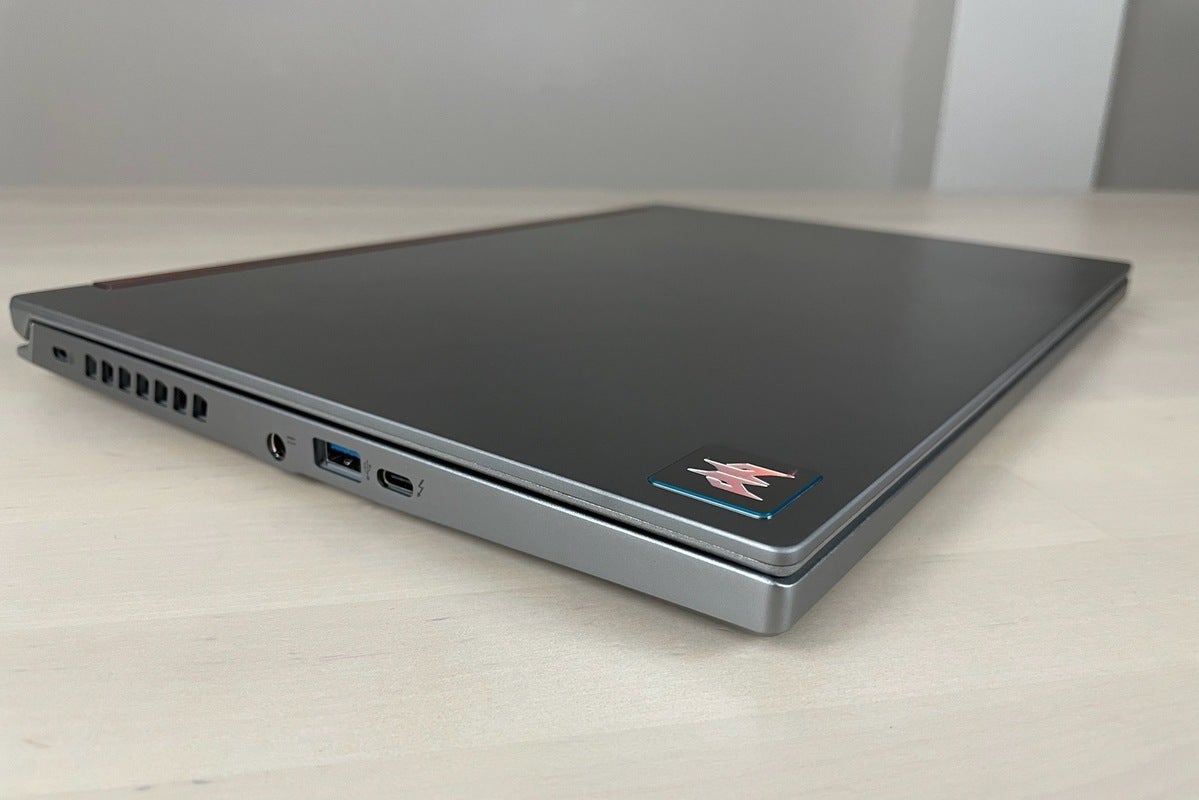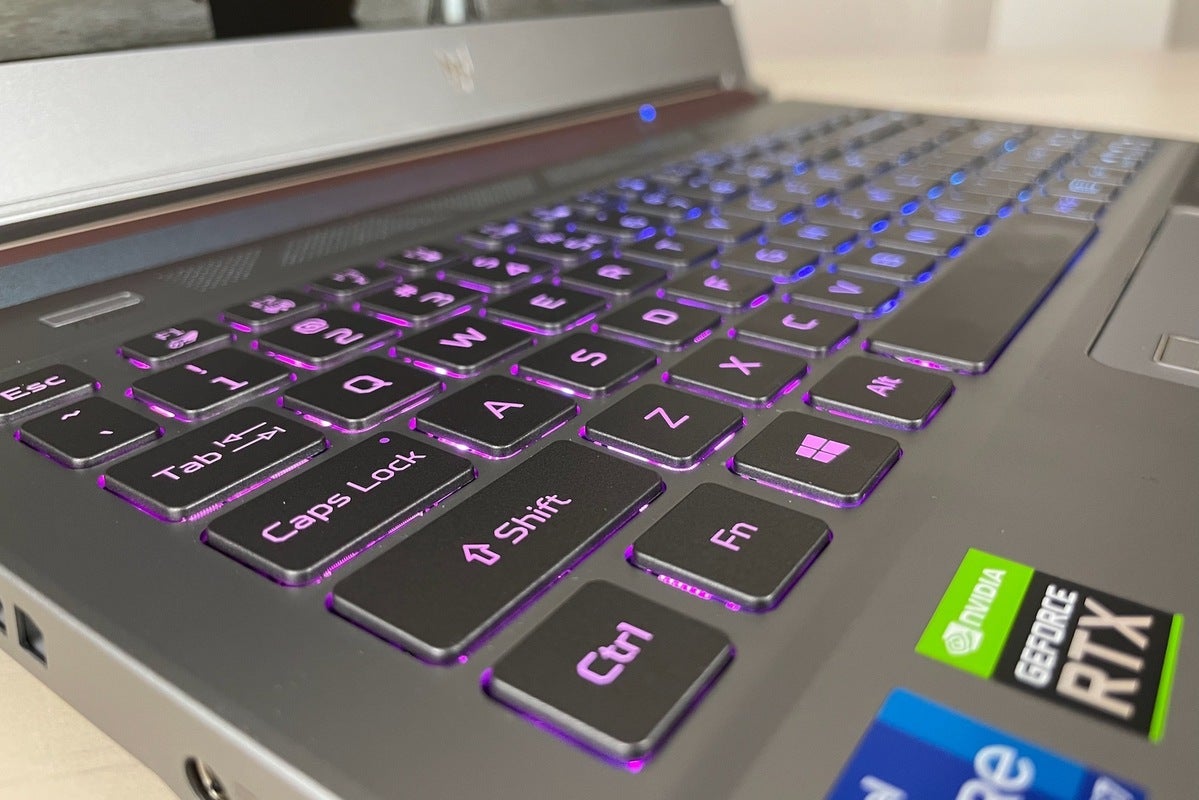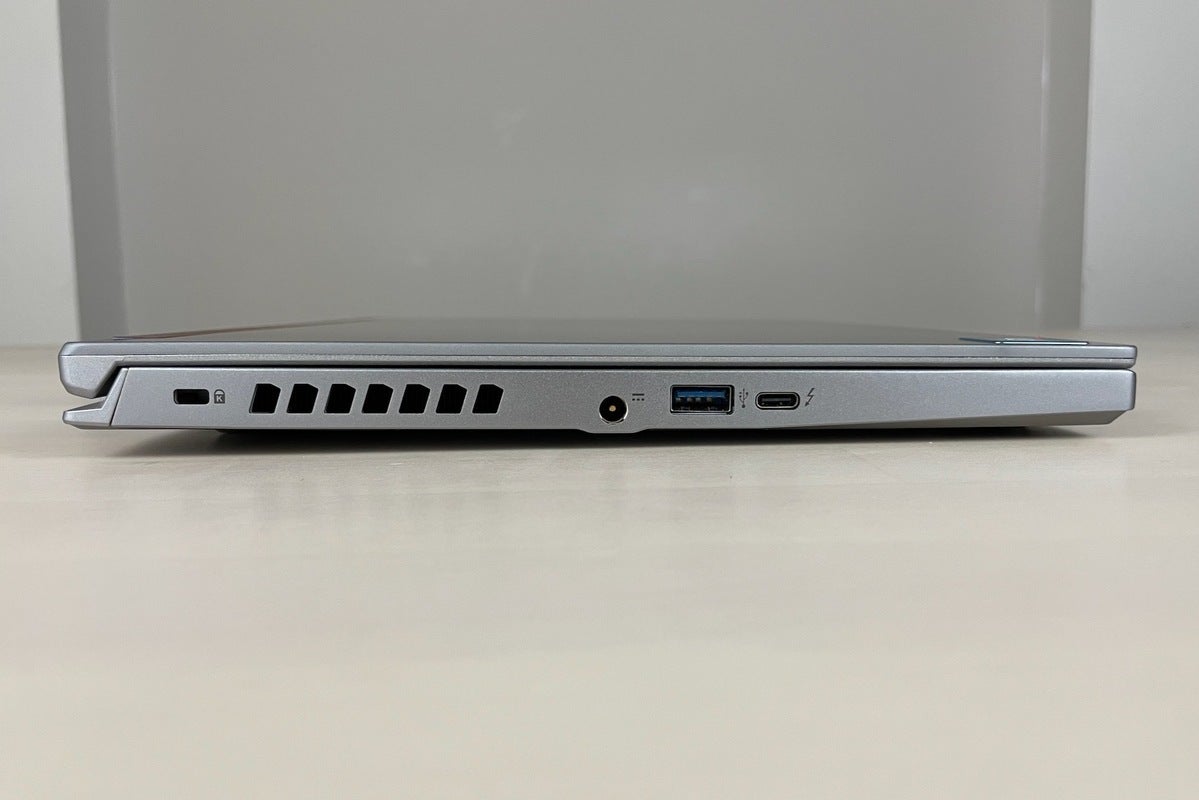[ad_1]
An on-the-go gaming rig with ray-tracing chops that won’t break your budget or your back, the Acer Predator Triton 300 SE serves up an enticing mix of value and performance. With a list price of $1,400 but currently on sale at Best Buy for just $1,300, the Predator Triton 300 SE arrives with Intel’s cutting-edge Tiger Lake H35 “ultraportable gaming” CPU, along with GeForce RTX 3060 graphics and a slim 3.8-pound design.
The Triton’s understated silver chassis gives the laptop a corporate look, but if you crack open the lid, you’ll find a 14-inch, 144Hz Full HD display, three-zone RGB keyboard backlighting, and one-touch overclocking. Thunderbolt 4 and solid battery life make a good thing even better.
This review is part of our ongoing roundup of the best laptops. Go there for information on competing laptops and how we tested them.
Configuration
The Acer Predator Triton 300 SE is one of the first laptops to pack Intel’s “Special Edition” 11th-gen Core H-series CPU, a so-called H35 chip that’s designed for a new class of (as Intel puts it) “ultraportable gaming” systems. Also inside: a GeForce RTX 3060 GPU, which boasts Nvidia’s Ampere 2nd-gen RTX architecture.
Let’s take a more detailed look under the hood:
- CPU: Quad-core Intel Core i7-11375H Special Edition
- Memory: 16GB DDR4 dual-channel SDRAM (upgradable to 24GB using a single soDIMM module)
- Graphics: GeForce RTX 3060 with 6GB GDDR6 VRAM
- Storage: 512GB NVMe SSD
- Display: 14-inch 1920×1080 IPS with 144Hz refresh rate, 300 nits
- Webcam: 720p SHDR
- Connectivity: Thunderbolt 4, two USB SuperSpeed 10Gbps Type-A ports (one with power-off USB charging), HDMI 2.1, 3.5mm combo audio jack
- Networking: Killer Wi-Fi 6 AX 1650, Bluetooth 5.1
- Biometrics: Fingerprint reader
- Battery capacity: 60 Whr
- Dimensions: 12.7 x 8.97 x 0.7 inches
- Weight: 3.8 pounds (measured), 1.3 pounds (AC adapter)
Starting at the top, Intel’s “Special Edition” H35 CPU promises up to 5GHz single-threaded performance (which we’ll be putting to the test later). The RTX 3060 card should serve up 1080p gaming frame rates north of 60 fps and “smooth” 4K gaming, complete with plenty of ray-tracing eye candy. The roomy 16GB of RAM can be upgraded to an even roomier 24GB, while the 14-inch IPS display can crank out 144Hz visuals (although you’ll have to do without G-Sync support).
Moving along, the 512GB solid-state drive won’t be enough to store your Steam library; thankfully, the Thunderbolt 4 port and the pair of SuperSpeed USB 10Gbps ports should be able to handle your external storage needs. There’s no ethernet, but you do get a Killer Wi-Fi 6 AX1650 low-latency wireless module with Bluetooth 5.1 and up to 2.4Gbps of throughput. Finally, a beefy 60 Whr battery should help boost your on-battery gaming time—although, realistically, you should keep the 1.3-pound AC adapter within reach.
As with other laptops in the Predator series, the Predator Triton 300 SE comes with Acer’s PredatorSense app, which offers the choice of four performance modes: Quiet, which keeps the laptop’s cooling fans as quiet as possible; Default, for “everyday use;” Extreme, which overclocks the CPU and GPU while throttling the cooling fans; and “Turbo,” which is designed to “maximize” overclocking while dialing up the cooling fans to a roar. The PredatorSense app lets you assign a performance mode (as well as lighting and sound modes) to specific games, but the laptop itself always boots into Default mode.
Design
Intel’s been making a push this year for low-profile, H35-powered “ultraportable gaming” laptops that won’t raise an eyebrow at work or on campus. The slim, all-silver Predator Triton 300 SE could certainly pass for one of Acer’s productivity-minded Aspire systems if you don’t look too hard.
 Ben Patterson/IDG
Ben Patterson/IDGThe Acer Predator Triton 300 SE cuts a slim, low-key profile for a gaming rig.
You won’t find any garish, bright-red highlights here—even the Predator logo on the corner of the lid is relatively tame. Of course, the jumbo vents on the sides and back of the laptop are a dead giveaway that this is a gaming rig. Measuring just 0.7 inches thick and weighing in at 3.8 pounds, the Triton 300 SE could be slipped into a backpack, although with its largish 14-inch display, you’ll certainly know it’s there.
Inside the Triton 300 SE’s chassis is a dual-fan cooling system featuring upgraded AeroBlade fans. According to Acer, its Vortex Flow technology is designed to “create an aerodynamic flow” courtesy of dedicated GPU and CPU heat pipes, while “strategically placed” fans help cool the DDR RAM, power supply, and other “critical” components. Will the Triton 300 SE’s thermal management solution translate into faster performance? We’ll soon see.
Display
The Acer Predator Triton 300 SE ships with a 14-inch full-HD (1920×1080) display with a 100-percent Adobe RGB color gamut and a fast, but not exceptional 144Hz refresh rate. Given the Triton 300 SE’s moderate price tag and its bleeding-edge H35 CPU, we’re not surprised that Acer opted to dial down the refresh rate a tad. If you’re looking for a gaming laptop with refresh rates in the ultra-fast 240Hz-300Hz range, you’ll need either to up your budget (substantially) or go for a more affordable system saddled with an older-gen CPU.
The IPS display delivers typically solid viewing angles. Its 300-nit maximum brightness spec is good, provided you keep the gaming indoors. The screen is surrounded by slim bezels on top and particularly along the sides, although the chunky bottom bezel is a bit of an eyesore. The top bezel, incidentally, houses the Triton’s 720p webcam and a three-mic array. The display isn’t touch-sensitive, but that’s common for a gaming laptop.
Keyboard, touchpad and speakers
The Triton 300 SE’s keyboard boasts three-zone RGB backlighting, which you can control via the PredatorSense app. You can pick from seven dynamic lighting profiles, ranging from “Breathing” and “Neon” to “Wave” and “Zoom,” or you can create your own static patterns.
 Ben Patterson/IDG
Ben Patterson/IDGThe Acer Predator Triton 300 SE comes with quiet keys and three-zone RGB keyboard backlighting.
As for the keyboard itself, the Triton 300 SE’s flat keys offer plenty of travel and are virtually silent. Gamers who prefer a smooth, linear-style action (ideal for those who want to flutter their fingers over the keyboard) might not like the solid, tactile bump at the actuation point, but again, that’s par for the course given the laptop’s price range.
The Triton 300 SE’s keyboard lacks media playback hotkeys, but there is a dedicated key that launches the PredatorSense app. A one-touch “Turbo” button sits above the left side of the keyboard. Positioned directly—and worryingly—above the PredatorSense button is the Power key, which immediately puts the Triton to sleep when struck. Take heed.
 Ben Patterson/IDG
Ben Patterson/IDGWatch out for the Power key that sits directly above the PredatorSense button.
The Triton’s compact glass touchpad felt smooth and responsive, with the cursor floating along in unison with a silky motion. The touchpad is small enough that my palms rarely brushed against it while I was typing, but even when I tried smashing both my palms on its surface, the cursors barely budged. There’s a fingerprint reader embedded in the top-left corner of the touchpad for those who want to enable biometric security.
The Acer Predator Triton 300 SE’s up-firing stereo speakers are augmented by DTS:X Ultra, an object-based sound format that competes with Dolby Atmos (an audio technology that commonly appears on Lenovo laptops). While object-based audio can effectively open up a laptop’s soundstage, it won’t necessarily improve overall audio performance, and that’s pretty much the case here. Whether I was running Vanguard strikes on Destiny 2 or listening to The Boss on Spotify, the Triton 300 SE’s speakers sounded disappointingly thin, with barely any bass response—in other words, par for the course as far as laptop speakers go. If you really want to crank the sound while listening or playing on the Triton, you’ll be better off with external speakers or a decent set of cans.
Ports
The Acer Predator Triton 300 SE comes with an impressive array of ports, which will come in handy for putting your Steam library on external storage as well as connecting gaming mice or controllers.
First and foremost is the left-side Thunderbolt 4 port, which can support up to two 4K monitors or a single 8K display at 60Hz. The Thunderbolt 4 spec also allows for connecting up to four Thunderbolt 4 hubs, as well as longer cable runs (including upcoming 50-meter optical cables) compared to Thunderbolt 3.
 Ben Patterson/IDG
Ben Patterson/IDGThunderbolt 4 headlines the Triton 300 SE’s array of ports. Also pictured: the first of two SuperSpeed 10Gbps Type-A ports, plus a barrel-shaped DC input.
Next to the Thunderbolt 4 port is the first of two SuperSpeed 10Gbps USB Type-A ports, along with a barrel-shaped power port for the bulky 180-watt AC adapter and a Kensington laptop security slot.
On the right side is the second SuperSpeed 10Gbps USB Type-A port, an HDMI 2.1 port, and a combo audio jack.
 Ben Patterson/IDG
Ben Patterson/IDGOn the right side: a second SuperSpeed USB 10Gbps Type-A port, an HDMI 2.1 port, and a combo audio jack.
Not bad, but there are a couple of omissions, including a media card reader and a wired ethernet port (although you could always just get a USB ethernet adapter).
Click here to read about the Acer Predator Triton 300 SE’s real-world performance and battery life.
[ad_2]
Source link